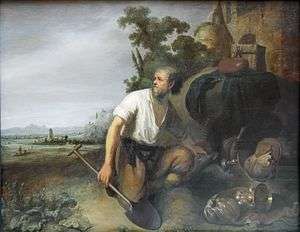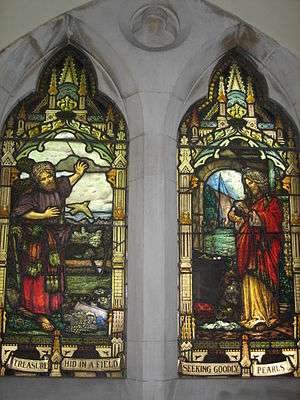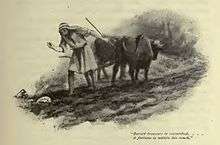Parable of the Hidden Treasure
The Parable of the Hidden Treasure is a well known parable of Jesus, which appears in Matthew 13:44, and illustrates the great value of the Kingdom of Heaven. It immediately precedes the parable of the Pearl, which has a similar theme. The parable has been depicted by artists such as Rembrandt.

Narrative
The brief parable of the hidden treasure is as follows:
"Again, the Kingdom of Heaven is like a treasure hidden in the field, which a man found, and hid. In his joy, he goes and sells all that he has, and buys that field."
— Matthew 13:44, World English Bible

The setting here presupposes that someone has buried a treasure and later died. The current owner of the field is unaware of its existence. The finder, perhaps a farm labourer, is entitled to it, but is unable to conveniently extract it unless he buys the field.[1] For a peasant, such a discovery of treasure represented the "ultimate dream."[2]
Interpretation
This parable is interpreted as illustrating the great value of the Kingdom of Heaven, and thus has a similar theme to the parable of the pearl. John Nolland comments that the good fortune reflected in the "finding" reflects a "special privilege,"[1] and a source of joy, but also reflects a challenge,[1] just as the man in the parable gives up all that he has, in order to lay claim to the greater treasure he has found.
John Calvin writes of this parable:
The first two of these parables are intended to instruct believers to prefer the Kingdom of heaven to the whole world, and therefore to deny themselves and all the desires of the flesh, that nothing may prevent them from obtaining so valuable a possession. We are greatly in need of such a warning; for we are so captivated by the allurements of the world, that eternal life fades from our view; and in consequence of our carnality, the spiritual graces of God are far from being held by us in the estimation which they deserve.[3]
The hidden nature of the treasure may indicate that the Kingdom of Heaven "is not yet revealed to everyone."[4]
However, other interpretations of the parable exist, in which the treasure represents Israel or the Church.[5]

In St. Thomas Aquinas' Catena Aurea, he compiles the comments of some of the Church Fathers on this passage,[6] who point out that like the treasure hidden in the field, the Gospel comes without cost, and is open to all – but to truly possess heavenly riches, one must be willing to give up the world to buy it. The Fathers also identify that the field in which the treasure is hidden is the discipline of Heavenly learning:
this, when a man finds, he hides, in order that he may preserve it; for zeal and affections heavenward it is not enough the we protect from evil spirits, if we do not protect from human praises. For in this present life we are in the war which leads to our country, and evil spirits as robbers beset us in our journey. Those therefore who carry their treasure openly, they seek to plunder in the way. When I say this; I do not mean that our neighbors should not see our works, but that in what we do, we should not seek praise from without. The kingdom of heaven is therefore compared to things of earth, that the mind may rise from things familiar to things unknown, and may learn to love the unknown by that which it knows is loved when known It follows, And for joy thereof he goes and sells all that he has, and buys that field. He it is that sells all he, has and buys the field, who, renouncing fleshly delights tramples upon all his worldly desires in his anxiety for the heavenly discipline.
The New Testament scholar Adolf Jülicher offers a deceptively simple explanation of the parable. He identifies three parts to parables or similitudes (extended similes or metaphors): the picture part (Bildhälfte), the reality part (Sachhälfte), and the point of comparison (teritium comparationis).[7] In this instance, the picture part is the hidden treasure, the reality part is God’s kingdom, and the point of comparison is the inestimable value of the kingdom.
In light of previous parables in Matthew where God or Jesus acts on behalf of his church, Lutheran theologian David P. Scaer understands the treasure in the field to be humanity, and the one purchasing the field to be Christ. Thus, as the man in the parable sells all that he has to buy the field, so Christ gives up his life in order to redeem humanity.[8]
Gospel of Thomas
A similar parable also appears in the Gospel of Thomas (Saying 109):[9]
Jesus said, "The (Father's) kingdom is like a person who had a treasure hidden in his field but did not know it. And [when] he died he left it to his [son]. The son [did] not know about it either. He took over the field and sold it. The buyer went plowing, [discovered] the treasure, and began to lend money at interest to whomever he wished."
— Gospel of Thomas 109, Patterson/Meyer translation
This work's version of the parable of the Pearl appears earlier (Saying 76), rather than immediately following, as in Matthew.[10] However, the mention of a treasure in Saying 76 may reflect a source for the Gospel of Thomas in which the parables were adjacent,[10] so that the original pair of parables has been "broken apart, placed in separate contexts, and expanded in a manner characteristic of folklore."[10] The multiple changes of ownership of the field are unique to the Gospel of Thomas,[10] and reflect a different theme from the New Testament parable.[4]
Depictions
There have been several depictions of the New Testament parable in art, including works by Rembrandt, Jan Luyken, James Tissot, and John Everett Millais.
See also
| Wikimedia Commons has media related to The Hidden Treasure. |
References
- John Nolland, The Gospel of Matthew: A commentary on the Greek text, Eerdmans, 2005, ISBN 0-8028-2389-0, pp. 563–65.
- Craig S. Keener, A Commentary on the Gospel of Matthew, Eerdmans, 1999, ISBN 0-8028-3821-9, p. 391.
- John Calvin, Commentary on Matthew, Mark, Luke – Vol. 2, transl. William Pringle, CCEL, Matthew 13:44–52.
- William David Davies & Dale C. Allison, A Critical and Exegetical Commentary on the Gospel According to Saint Matthew: Commentary on Matthew VIII–XVIII, Continuum, 1997, ISBN 0-567-09545-2, pp. 435–37.
- Herbert Lockyer, All the Parables of the Bible, Zondervan, 1988, ISBN 0-310-28111-3, pp. 197–200.
- "Matthew 13". Catena aurea. Catechetics online. Archived from the original on 2016-05-16. Retrieved 2016-05-14.
- Adolf Jülicher 1910, Die Gleichnisreden Jesu, 2nd ed. (Tübingen: J. C. B. Mohr); James L. Resseguie, Narrative Criticism of the New Testament: An Introduction, Grand Rapids: Baker Academic, 2005, 63–64.
- David P. Scaer, Discourses in Matthew: Jesus teaches the church, Concordia Publishing House, 2004, ISBN 0-7586-0339-8, pp. 310-315
- Gospel of Thomas: Lamb translation and Patterson/Meyer translation.
- Brad H. Young, The Parables: Jewish Tradition and Christian Interpretation, Hendrickson Publishers, 2008, ISBN 1-59856-303-3, pp. 202–206.